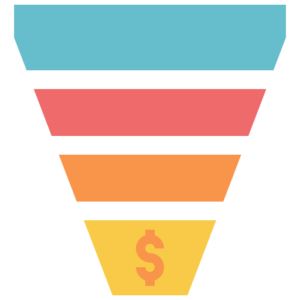What is a lead funnel?

In 2022, all businesses aim to maximize their revenue and customer base. With millions of businesses still battling to recover from the financial setbacks of the previous two years, finding and retaining new (and loyal) customers is important.
But how to get these customers? And how can you get them to do business with you? Ads and social media campaigns are great for promoting your business, but they rarely close deals on their own.
You need a well-organized lead funnel for more customers.
In this article, we’ll walk you through the fundamentals of a successful lead funnel and explain why your job doesn’t end with lead generation. To build a larger customer base, you must go on the journey with your prospects rather than simply waiting for them at the cash register.
What is a lead funnel?
In a lead funnel, a potential buyer knows about your product, expresses interest in it, and then moves through your funnel to become a buyer.
Building a lead funnel is critical for every organisation that wants to maximise its return on investment. However, before you begin planning the construction of a lead funnel, you need be informed of the many stages of the lead funnel.
How Lead Funnels Work
Lead funnels effectively work by organising your complete lead process (from marketing to sales) to make it easier and quicker to convert leads. That doesn’t mean that every prospect receives the same treatment—personalization in marketing and active listening in sales remain critical to customer conversion—but it does indicate that all prospects will go through similar processes during their buyer journey.
Not all prospects will make it all the way down the funnel on the first try; some may never make it. That’s OK. The funnel’s most essential feature is that it unites the efforts of everyone on the sales and marketing teams so that each consumer is provided with a consistent image of a brand and sales style.
Lead funnel stages
- Awareness –These top-of-funnel leads have start aware of your business. They might have read one of your blog posts or liked one of your Posts on instagram.
- Interest – That indicates they are aware of your product’s existence and are viewing it as a possible solution to their problem.
- Desire – Now leads are interested in an offer they saw in your content. This is typically a lead magnet you’ve generated, such as a free video course or guide.
- Conversion – You’ve completed the task. Your lead is interested in the product, seems to be purchasing it, and is prepared to buy it.
Conclusion
Lead funnel is the process of reaching potential customers to your business in the goal of converting them into sales.
The lead funnel is a process of engaging with these customers in order to encourage them to learn more about your company and choose you over the competition.
Ideally, you will be able to turn leads into sales and help your business expand by including efficient lead funnel strategies into your plan.
Remember, if this is still confusing to you, there are specialists, such as Autoresponderz, whose business it is to make it much easier.
